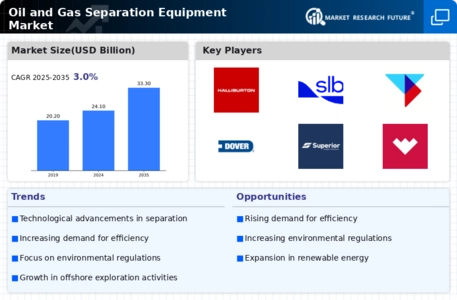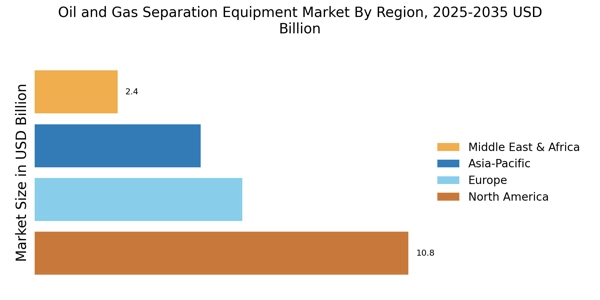Environmental Regulations
The increasing stringency of environmental regulations is a significant driver for the Oil and Gas Separation Equipment Market. Governments worldwide are implementing stricter policies aimed at reducing emissions and minimizing environmental impact. This regulatory landscape compels companies to invest in advanced separation technologies that comply with these standards. For example, the implementation of zero-liquid discharge systems is becoming more prevalent as firms strive to meet regulatory requirements. As a result, the demand for innovative separation equipment that aligns with environmental regulations is likely to surge, propelling the growth of the Oil and Gas Separation Equipment Market. Companies that proactively adapt to these regulations may gain a competitive edge in the market.
Technological Innovations
Technological advancements play a crucial role in shaping the Oil and Gas Separation Equipment Market. Innovations such as advanced separation techniques, automation, and real-time monitoring systems are transforming traditional processes. These technologies not only improve efficiency but also reduce operational costs. For instance, the introduction of membrane separation technology has shown promise in enhancing the purity of extracted resources. Furthermore, the market is witnessing a shift towards digital solutions, with predictive maintenance and data analytics becoming integral to operations. As companies adopt these cutting-edge technologies, the Oil and Gas Separation Equipment Market is expected to experience substantial growth, driven by the need for enhanced productivity and reduced environmental impact.
Increasing Demand for Energy
The escalating The Oil and Gas Separation Equipment Industry. As economies continue to grow, the need for reliable energy sources intensifies. This demand is particularly pronounced in emerging markets, where industrialization and urbanization are rapidly advancing. According to recent data, the energy consumption in these regions is projected to rise significantly, necessitating efficient extraction and processing methods. Consequently, the Oil and Gas Separation Equipment Market is poised to expand as companies seek advanced separation technologies to optimize production and meet energy needs. The integration of innovative equipment is likely to enhance operational efficiency, thereby supporting the overall growth of the market.
Focus on Operational Efficiency
The relentless pursuit of operational efficiency is driving the Oil and Gas Separation Equipment Market. Companies are increasingly seeking ways to optimize their processes to reduce costs and enhance productivity. This focus on efficiency is leading to the adoption of advanced separation technologies that streamline operations. For instance, the use of high-performance separators can significantly reduce downtime and improve recovery rates. Additionally, the integration of automation and smart technologies is enabling real-time monitoring and control, further enhancing operational efficiency. As firms prioritize these improvements, the Oil and Gas Separation Equipment Market is likely to witness robust growth, as efficient operations become a key differentiator in a competitive landscape.
Rising Investment in Oil and Gas Exploration
The resurgence of investment in oil and gas exploration is a pivotal driver for the Oil and Gas Separation Equipment Market. As oil prices stabilize, companies are increasingly allocating resources towards exploration and production activities. This renewed focus on upstream operations necessitates the deployment of advanced separation equipment to ensure efficient processing of extracted resources. Recent data indicates that exploration budgets are on the rise, particularly in regions with untapped reserves. Consequently, the demand for effective separation technologies is expected to grow, as companies seek to maximize output and minimize waste. This trend is likely to bolster the Oil and Gas Separation Equipment Market, as investments in exploration translate into increased equipment procurement.



















Leave a Comment